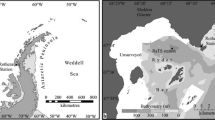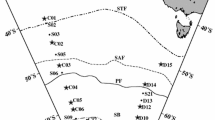Abstract
Phytoplankton in the mixed layer is exposed to increasing levels of light when transported to the surface layer of the ocean. The photoprotective response of natural assemblages of phytoplankton can differ among community structures. We investigated photoprotective acclimation and xanthophyll cycle pigments in size-fractionated natural phytoplankton assemblages during the austral summer in the Indian sector of the Southern Ocean. We estimated concentrations of phytoplankton pigments in the micro-size fractions (>20 μm) and nano-size fractions (2–20 μm) by subtracting concentrations in the <20 μm fractions from concentrations in the bulk samples, and by subtracting concentrations in the <2 μm fractions from concentrations in the <20 μm fractions, respectively. Changes in the ratios of the xanthophyll cycle pigments diadinoxanthin (DD) and diatoxanthin (DT) were determined at three optical depths in the mixed layer and during 48 h deck incubations under solar photosynthetically available radiation and ultraviolet radiation. Large variations in (DD + DT)/Chl a in the mixed layer (percent coefficient of variation >67 %) and in deck incubation bottles under variable light conditions (>75 % of the temporal variation) for the micro-size fractions suggest a higher potential for photoprotective acclimation than for the nano-size fractions. Decreases in DT/(DD + DT) with increases in the optical depth of the mixed layer (ζ MLD) suggest that larger variations in light availability in the mixed layer might predict lower values of DT/(DD + DT) at the surface, regardless of cell size.






Similar content being viewed by others
References
Alderkamp A-C, de Baar HJW, Visser RJW, Arrigo KR (2010) Can photoinhibition control phytoplankton abundance in deeply mixed water columns of the Southern Ocean? Limnol Oceanogr 55:1248–1264
Alderkamp A-C, Mills MM, van Dijken GL, Arrigo KR (2013) Photoacclimation and non-photochemical quenching under in situ irradiance in natural phytoplankton assemblages from the Amundsen Sea, Antarctica. Mar Ecol Prog Ser 475:15–34
Bidigare RR, Smith RC, Baker KS, Marra J (1987) Oceanic primary production estimates from measurements of spectral irradiance and pigment concentrations. Glob Biogeochem Cycles 1:171–186
Brunet C, Brylinski JM, Lemoine Y (1993) In situ variations of the xanthophylls diatoxanthin and diadinoxanthin: photoadaptation and relationships with a hydrodynamical system in the eastern English Channel. Mar Ecol Prog Ser 102:69–77
Brunet C, Casotti R, Aronne B, Vantrepotte V (2003) Measured photophysiological parameters used as tools to estimate vertical water movements in the coastal Mediterranean. J Plankton Res 25:1413–1425
Brunet C, Casotti R, Vantrepotte V, Conversano F (2007) Vertical variability and diel dynamics of picophytoplankton in the Strait of Sicily, Mediterranean Sea, in summer. Mar Ecol Prog Ser 346:15–26
Brunet C, Johnsen G, Lavaud J, Roy S (2011) Pigments and photoacclimation processes. In: Roy S, Llewellyn CA, Egeland S, Johnsen G (eds) Phytoplankton pigments: characterization, chemotaxonomy and applications in oceanography. Cambridge University Press, Cambridge, pp 445–471
Buma AGJ, Wright SW, van den Enden R, van de Poll WH, Davidson AT (2006) PAR acclimation and UVBR-induced DNA damage in Antarctic marine microalgae. Mar Ecol Prog Ser 315:33–42
Burkill PH, Mantoura RFC, Llewellyn CA, Owens NJP (1987) Microzooplankton grazing and selectivity of phytoplankton in coastal waters. Mar Biol 93:581–590
Chiba S, Hirawake T, Ushio S, Horimoto N, Satoh R, Nakajima Y, Ishimaru T, Yamaguchi Y (2000) An overview of the biological/oceanographic survey by the RTV Umitaka-maru III off Adelie Land, Antarctica in January–February 1996. Deep Sea Res Pt II 47:2589–2613
Claustre H, Kerhervé P, Marty J-C, Prieur L (1994) Phytoplankton photoadaptation related to some frontal physical processes. J Mar Syst 5:251–265
de Salas MF, Eriksen R, Davidson AT, Wright SW (2011) Protistan communities in the Australian sector of the Sub-Antarctic zone during SAZ-Sense. Deep Sea Res Pt II 58:2135–2149
Demers S, Roy S, Gagnon R, Vignault C (1991) Rapid light-induced changes in cell fluorescence and in xanthophyll-cycle pigments of Alexandrium excavatum (Dinophyceae) and Thalassiosira pseudonana (Bacillariophyceae): a photo-protection mechanism. Mar Ecol Prog Ser 76:185–193
Doblin MA, Petrou KL, Shelly K, Westwood K, van den Enden R, Wright S, Griffiths B, Ralph PJ (2011) Diel variation of chlorophyll-a fluorescence, phytoplankton pigments and productivity in the Sub-Antarctic and Polar Front Zones south of Tasmania, Australia. Deep Sea Res Pt II 58:2189–2199
Eppley RW (1972) Temperature and phytoplankton growth in the sea. Fish Bull 70:1063–1085
Falkowski PG (1983) Light-shade adaptation and vertical mixing of marine phytoplankton: a comparative field study. J Mar Res 41:215–237
Finkel ZV (2001) Light absorption and size scaling of light-limited metabolism in marine diatoms. Limnol Oceanogr 46:86–94
Fujiki T, Taguchi S (2001) Relationship between light absorption and the xanthophyll-cycle pigments in marine diatoms. Plankton Biol Ecol 48:96–103
Fujiki T, Toda T, Kikuchi T, Taguchi S (2003) Photoprotective response of xanthophyll pigments during phytoplankton blooms in Sagami Bay, Japan. J Plankton Res 25:317–322
Griffith GP, Vennell R, Williams MJM (2010) An algal photoprotection index and vertical mixing in the Southern Ocean. J Plankton Res 32:515–527
Hashihama F, Hirawake T, Kudoh S, Kanda J, Furuya K, Yamaguchi Y, Ishimaru T (2008) Size fraction and class composition of phytoplankton in the Antarctic marginal ice zone along the 140°E meridian during February–March 2003. Polar Sci 2:109–120
Hashihama F, Umeda H, Hamada C, Kudoh S, Hirawake T, Satoh K, Fukuchi M, Kashino Y (2010) Light acclimation states of phytoplankton in the Southern Ocean, determined using photosynthetic pigment distribution. Mar Biol 157:2263–2278
Kirk JTO (1994) Concepts of hydrologic optics. In: Kirk JTO (ed) Light and photosynthesis in aquatic ecosystems, 2nd edn. Cambridge University Press, Cambridge, pp 3–25
Kopczyńska EE, Savoye N, Dehairs F, Cardinal D, Elskens M (2007) Spring phytoplankton assemblages in the Southern Ocean between Australia and Antarctica. Polar Biol 31:77–88
Kropuenske LR, Mills MM, van Dijken GL, Bailey S, Robinson DH, Welschmeyer NA, Arrigo KR (2009) Photophysiology in two major Southern Ocean phytoplankton taxa: photoprotection in Phaeocystis antarctica and Fragilariopsis cylindrus. Limnol Oceanogr 54:1176–1196
Lavaud J, Rousseau B, Etienne A-L (2004) General features of photoprotection by energy dissipation in planktonic diatoms (Bacillariophyceae). J Phycol 40:130–137
MacIntyre HL, Kana TM, Geider RJ (2000) The effect of water motion on short-term rates of photosynthesis by marine phytoplankton. Trends Plant Sci 5:12–17
Mills MM, Kropuenske LR, van Dijken GL, Alderkamp A-C, Berg GM, Robinson DH, Welschmeyer NA, Arrigo KR (2010) Photophysiology in two southern ocean phytoplankton taxa: photosynthesis of Phaeocystis antarctica (Prymnesiophyceae) and Fragilariopsis cylindrus (Bacillariophyceae) under simulated mixed-layer irradiance. J Phycol 46:1114–1127
Moisan TA, Olaizola M, Mitchell BG (1998) Xanthophyll cycling in Phaeocystis antarctica: changes in cellular fluorescence. Mar Ecol Prog Ser 169:113–121
Moline MA (1998) Photoadaptive response during the development of a coastal Antarctic diatom bloom and relationship to water column stability. Limnol Oceanogr 43:146–153
Odate T, Fukuchi M (1995) Physical and chemical properties of surface water in the Southern ocean in summer 1991/92. Proc NIPR Symp Polar Biol 8:77–85
Orsi AH, Whitworth T III, Nowlin WD Jr (1995) On the meridional extent and fronts of the Antarctic Circumpolar Current. Deep Sea Res Pt I 42:641–673
Paerl HW, Tucker J, Bland PT (1983) Carotenoid enhancement and its role in maintaining blue-green algal (Microcystis aeruginosa) surface blooms. Limnol Oceanogr 28:847–857
Strom SL, Welschmeyer NA (1991) Pigment-specific rates of phytoplankton growth and microzooplankton grazing in the open subarctic Pacific Ocean. Limnol Oceanogr 36:50–63
Suzuki R, Ishimaru T (1990) An improved method for the determination of phytoplankton chlorophyll using N,N-dimethylformamide. J Oceanogr 46:190–194
Thompson PA, Pesant S, Waite AM (2007) Contrasting the vertical differences in the phytoplankton biology of a dipole pair of eddies in the south-eastern Indian Ocean. Deep Sea Res Pt II 54:1003–1028
Wright SW, Thomas DP, Marchant HJ, Higgins HW, Mackey MD, Mackey DJ (1996) Analysis of phytoplankton of the Australian sector of the Southern Ocean: comparisons of microscopy and size frequency data with interpretations of pigment HPLC data using the ‘CHEMTAX’ matrix factorisation program. Mar Ecol Prog Ser 144:285–298
Wright SW, Jeffrey SW, Mantoura RFC (1997) Evaluation of methods and solvents for pigment extraction. In: Jeffrey SW, Mantoura RFC, Wright SW (eds) Phytoplankton pigments in oceanography: guidelines to modern methods. UNESCO, Paris, pp 261–282
Acknowledgments
The authors wish to thank G. Hashida and M. Moteki for supporting the cruises and this study. The authors also wish to thank V.S. Kuwahara, T. Hirawake, T. Iida, S. Takao, and H. Endo for providing technical support for the experiments. The authors also wish to thank the captain, officers, and crew of the TR/V Umitaka-maru, the students of the Tokyo University of Marine Science and Technology, and the scientists of JARE-52 and -53, especially F. Akiha and S. Suganami, for technical assistance with sampling. This work was supported in part by the RAMEEC (Responses of Antarctic Marine Ecosystems to global Environmental Changes with Carbonate systems) project of JARE. We thank the anonymous reviewers for their constructive suggestions and comments.
Author information
Authors and Affiliations
Corresponding author
Rights and permissions
About this article
Cite this article
Motokawa, S., Hattori, H., Sasaki, H. et al. Photoprotective acclimation of micro- and nano-size phytoplankton assemblages in the Indian sector of the Southern Ocean. Polar Biol 37, 1373–1381 (2014). https://doi.org/10.1007/s00300-014-1527-5
Received:
Revised:
Accepted:
Published:
Issue Date:
DOI: https://doi.org/10.1007/s00300-014-1527-5




